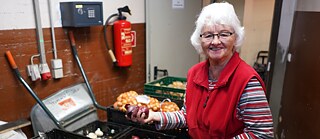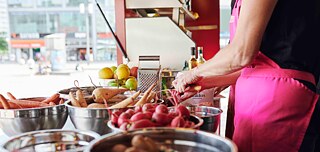Rescuing Food
Can This Still Be Eaten or Does It Have to Go?

Almost 13 million tons of food goes to waste in Germany every year. The Ministry of Food and Agriculture has ambitious plans halve domestic food waste by 2030, a problem private initiatives have already begun addressing.
Each year, every German household tosses out 75 kilograms of food. Commissioned by the Ministry of Food and Agriculture (BMEL), the University of Stuttgart and the Johann Heinrich von Thünen Institute developed these estimates in 2019. All those apples, bread and cheese that end up in the rubbish bin represent a waste of important resources, like arable land, water, and fertilizer, and the energy that goes into harvesting, processing and transport. Looking for ways to address this issue, the BMEL launched the Zu gut für die Tonne! (Too good for the bin!) intiaitive aimed at halving per capita food waste in German by 2030. This is by no means a new issue though, and many initiatives have long been committed to combatting food waste.
The Wishing Table
One of the largest social movements in Germany is leading by good example: Since 1993, the charitable organisation Die Tafeln (the Tables), supported entirely by donations, has been collecting high-quality food throughout Germany - mostly unsold food from grocery stores - and distributing it for free or for a nominal amount to economically disadvantaged people. At present, the Tafeln rescue around 264,000 tonnes of food from 30,000 supermarkets in Germany every year. A new app will soon go live to help make food distribution even more efficient in future.
Zero Waste: Cooking from the Root to the Leaves
Numerous smaller initiatives offer cooking courses designed to raise our appreciation for the food we consume daily, especially the fresh fruit and vegetables that are the most frequently thrown away foods in German households. Founded in 2014, the Restlos Glücklich association in Berlin organizes workshops on food waste and climate-friendly nutrition. Zero-waste cooking seminars show users creative ways to use leftovers as online cooks simmer a delicious soup made from cauliflower leaves live on the internet. These food waste watchers are following the popular ideas of Esther Kern, an initiator of the leaf-to-root movement in Germany. She uses the entire vegetable in her cooking from the leaf to the root: spiced pumpkin-leaf purée, radish leaf salad with pumpkin seeds paired with miso soup made from the scraps and peel. Little remains for the compost pile.
Wasteful Households
The retail sector in Germany only accounts for four percent of the food thrown away and more than half of all food waste comes from private households that generate around seven million tonnes every year. According to the Stuttgart study, around 40 percent of food waste could be avoided if consumers bought less, stored their purchases correctly and tried to reuse rather than just toss out leftovers. This is where the app from the Zu gut für die Tonne! campaign can help consumers plan their grocery shopping and pantry stock, store foods better and recycle leftovers using one of more than 400 recipes.The Sell-By Date Is Not Set in Stone
The best-before date is another major reason for food waste. Contrary to widespread opinion, the sell-by date is just a guideline and not the day a product should be thrown away. Food can often still be eaten days or even months after it has supposedly expired. A Forsa study found that one in five Germans tosses food in the bin just because it has passed its sell-by date. The Stuttgart-based Tsenso company is working on a new app to address this issue. The Fresh Index app determines the real-time best-before date. End consumers can simply scan the barcode to see just how fresh a foodstuff really is. And like Restlos Glücklich from Berlin, Tsenso was nominated for the 2020 Zu gut für die Tonne Award.Sharing Food
There is now a whole bouquet of apps and online initiatives for leftover recyclers and food conservationists. You can order from Sirplus, an online supermarket for surplus food, or buy bent vegetables from organic farmers via Etepetete. Many also use formats like Foodsharing. The initiative was launched in Berlin in 2012 and has grown into an international movement with over 200,000 participants in Germany, Austria, Switzerland and other European countries. Foodsharers rescue unwanted and overproduced food from private households or businesses and post it to the website or unload it at a “Fair-Teiler” or fair distributor, shelves or refrigerators in easily accessible places like on university campuses or in club rooms, where leftover food can be stored and is available for free. The fair distributors are entered into the platform and displayed on a map for all users. The Uxa app can also be used to get leftover food onto the plates of hungry eaters.